Health Science | Student Engagement | Teaching Strategies
5 Bell Ringer Activities to Engage Your Health Science Students
With past experience in teaching, a couple of degrees in writing, and an upbringing immersed in medical jargon, Mike is positioned well to hear out the most common questions teachers ask about the iCEV curriculum. His goal is to write content that quickly and effectively answers these questions so you can back to what matters - teaching your students.
When students first walk into your classroom, they’re fresh off of all sorts of distractions, from friends to phones to life. Oftentimes the last thing they want to do is sit down and learn about health science.
For the dedicated health science teacher, this can be a problem: Disinterested students are students who aren’t learning, and because you want your class time to be as productive as possible, you need to gain and keep your students’ attention as soon as they take their seats.
However, engaging your students quickly can be more complicated than it seems, and to do it well, you’re going to need some strategies to hook ‘em in.
At iCEV, we’ve heard hundreds of teachers talk about their issues with student engagement. To answer these concerns, we’ve gathered activities and assignments, called bell ringers, that will quickly grab your students and refocus them on your health science course material.
In this article, you’ll find the 5 best bell ringer activities to engage your health science students right out of the gate:
- Question of the Day
- Medical Terminology Review
- Diseases and Disorders Review
- Current Event Articles
- Gauge Their Knowledge
By the end of this article, you’ll be able to ground your students’ attention using reliable, relevant bell ringers designed for health science classes.
What Is a Bell Ringer Activity?
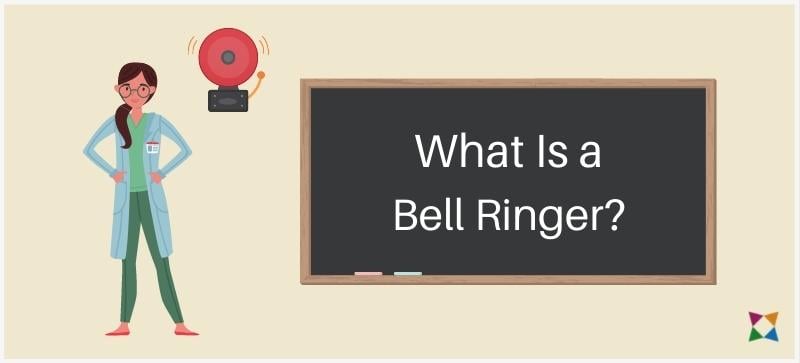
A bell ringer is a short assessment, activity, or assignment that students complete as soon as they enter a classroom.
Typically, bell ringers indicate to students that class has begun and immediately engage students’ attention by priming them to think about the course material.
There are many examples of bell ringers, but they vary depending on the subject matter of a class:
- Math classes frequently have students complete practice problems at the beginning of class to refresh their minds on a previous lesson’s theorems or equations.
- English classes often include writing activities like Write for Fives, where students spend five minutes journaling their thoughts going into each lesson.
- Science classes may have students complete short vocab quizzes on important terms they learned in a prior lesson or from a textbook.
While these activities are useful for other subjects, when it comes to health science, there are more appropriate bell ringers that will go a lot further in winning over your students!
5 Best Bell Ringer Activities to Engage Your Health Science Students
1. Question of the Day
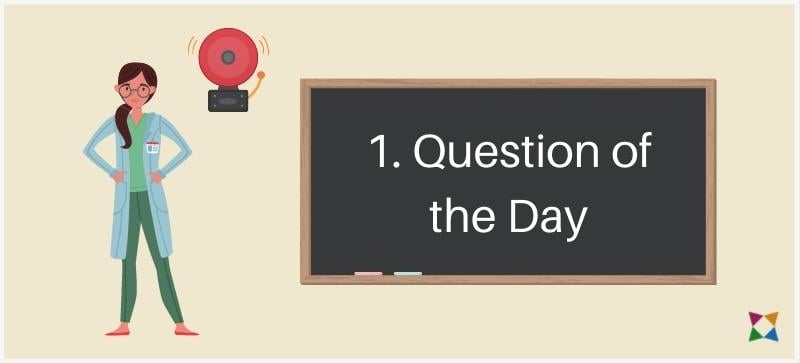
A great way to both prepare your students for a day’s lesson and refresh them on a previous day’s lesson is to ask them a Question of the Day.
Questions of the Day can come in many forms, but generally they should be specific, thought-provoking, and relate to a previous day’s lesson.
In other words, if your students pay attention, they should have all the tools they need to answer it.
What Are Some Example Questions of the Day?
To effectively use a Question of the Day:
- Either write the question on a board or otherwise present it to your students.
- After you’ve written it, give your students a few minutes to think about or write down their responses.
- When they’re done, you can either call on one of your students, have each turn in their response, or use the Question of the Day as a springboard to start a class discussion.
Try to make your Question of the Day interesting so it grabs your students’ attention. For example, if you’re teaching a unit on mental or behavioral disorders, some solid Questions of the Day might include:
- How is depression different from sadness?
- What are some stigmas you’ve witnessed surrounding mental disorders?
- Pick one of the disorders we discussed yesterday. How would you medically treat someone with this disorder?
Rather than just forcing students to list off facts or figures, with the right Questions of the Day you can engage your students’ critical thinking skills and get them to expand on their existing knowledge.
2. Medical Terminology Review
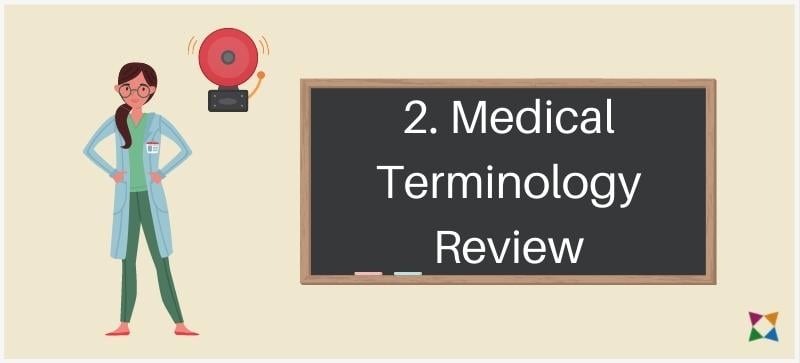
If your students are word-obsessed and interested in vocab, then reviewing medical terminology can be a good way to quickly rope them into your lesson and keep them engaged throughout.
This bell ringer encourages creativity and fun in how you implement it. For instance, you can make a game out of reviewing important medical prefixes, suffixes, and abbreviations to better solidify these terms in your students’ minds.
What Are Specific Examples of Med-Term Review in Action?
There are several ways you could implement a medical terminology review bell ringer in your classroom. However, going off the above activity, a specific example might look like:
- Present students with 2-3 medical terms (e.g. Osteoarthritis, Cardiomyopathy, and Lymphocyte).
- Have them identify the important root word in each (e.g. Osteoarthritis, Cardiomyopathy, Lymphocyte).
- Have them define each root (e.g. “Osteo” = “bone”, “Cardio” = “heart”, “Cyte” = “cell”).
- From there, students can attempt to put together the meaning of the entire word.
Alternatively, you could present them with medical abbreviations and have them attempt to identify what each means. A particular example might be:
- Present students with 2-3 medical abbreviations (e.g. CPAP and COPD).
- Have them attempt to determine what the abbreviation stands for (e.g. “Continuous positive airway pressure” and “Chronic obstructive pulmonary disease”).
There are many ways that you can incorporate medical terminology review as a bell ringer, but as long as you have fun and make it as entertaining as it is informative, this can be a great way to start your health science classes.
3. Diseases and Disorders Review
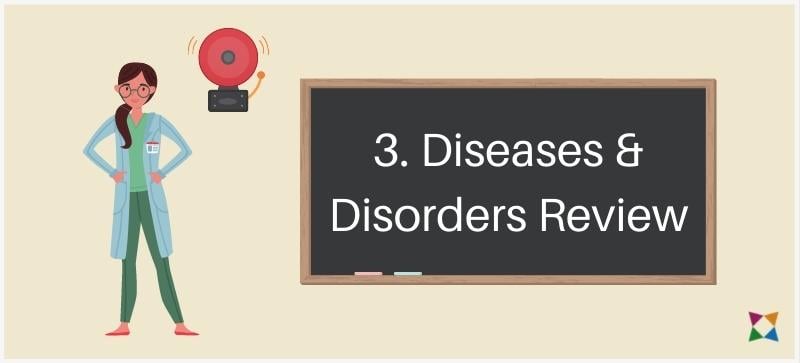
Some diseases can be fascinating to learn about, and may naturally draw the intrigue of your students if you include them in a bell ringer.
With that in mind, a great way to engage your students as soon as they enter your classroom is to review some diseases and disorders with them!
What Is a Specific Example of a Diseases and Disorders Review in Action?
There are several ways you could include a diseases and disorders activity in your classroom, but one way might be:
- Present students with 2-3 symptoms (e.g. Chest tightness, shortness of breath, wheezing during exhalation).
- Have your students identify the disease or disorder the symptoms belong to (e.g. Asthma).
- Repeat with a different disease and different symptoms.
- If no students can identify the disease, consider having them search the symptoms online to see if they can find an answer via the internet.
If you use this bell ringer well, you’ll immediately grab your students’ attention by appealing to their interest in compelling diseases and disorders.
4. Current Event Articles

If you want to make your course material feel timely and important, consider having your students research current events relevant to your class.
After all, if you can demonstrate how your course material relates to significant goings-on in the world, it will feel more relatable to your students. It also pushes students to think critically about your class and make connections between your lessons and their everyday lives.
Depending on the drama of the events you have in mind, this could be a very attention-grabbing bell ringer. To use it effectively, however, you’ll have to keep your eyes open for relevant current event articles for your students to read on the day-to-day.
What Is a Specific Example of a Current Event Article Activity?
If you’re teaching a unit on infection control, an example of this kind of activity in action might look like:
- Present your students with an article on the role hand sanitizer plays in preventing COVID infections.
- Have them read the article.
- Have them draw connections between the article and the current infection control course material.
- Open class discussion into the article to gauge everyone’s thoughts.
If you do this right, your students will have a firsthand look into how relevant their course material is to the world at large. The lessons they’re learning will stop being theoretical and will begin to present real-world ramifications.
5. Gauge Their Knowledge
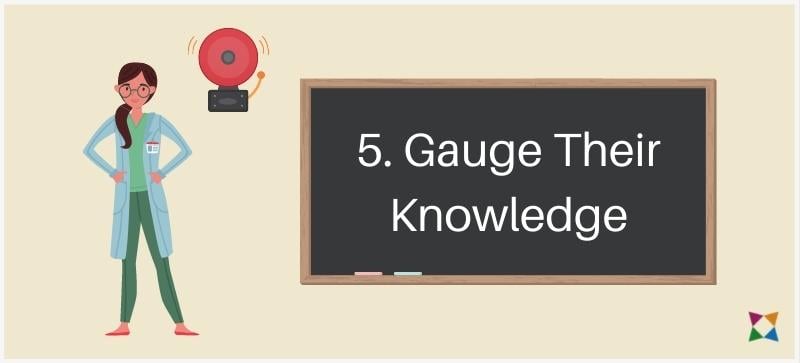
Gauging your students’ knowledge can be another solid bell ringer to kick off your CTE health science class.
Students often like having their knowledge of specific topics probed by teachers in preparation for a lesson.
If it’s a topic the student is already confident they know well, answering your questions correctly will get them excited about enhancing their understanding. And if they don’t know the answer, no problem! That just gives them more room to learn the topic in the first place.
In many ways, this bell ringer may play out similar to a Question of the Day activity, but while a Question of the Day is focused on a previous day’s lesson, gauging student knowledge takes place before the lesson on a topic.
What Is an Example of Gauging Student Knowledge?
When getting a grasp on how much students know about a subject, try to be intriguing with your questions.
For example, if you’re about to teach a unit on shock and resuscitation, here’s a way you might gauge student knowledge:
- Ask them what a patient in shock looks like, or perhaps the proper procedure for managing a patient who’s in shock.
- Have them respond either written or verbally.
- Take into account their responses, and focus on an answer that will serve to spring you into your lesson for the day.
When you effectively leverage this bell ringer, your students will feel encouraged about their knowledge, and you’ll also get a sense of where their understanding rests regarding the lesson at hand.
Keeping Your Students Engaged Beyond Bell Ringers
Alright, so you’ve learned some of the best bell ringers for gaining your students’ attention as soon as they walk into your health science class. If you use them--and use them right--you’ll be making your classroom as productive and exciting as possible right out of the gate.
But the battle for student engagement doesn’t end there. If you’re like many CTE health science teachers, you also want strategies that go beyond getting a strong start in class. You want resources to help keep your students engaged throughout your entire lesson, rather than just the beginning.
If that’s the case, check out this article on other methods you can use to grab, and hold, student focus in your CTE health science class:


